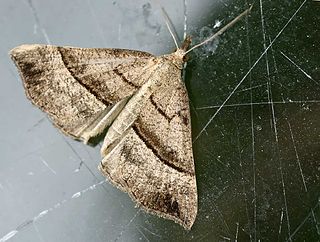
Noctuoidea is the superfamily of noctuid or "owlet" moths, and has more than 70,000 described species, the largest number of any Lepidopteran superfamily. Its classification has not yet reached a satisfactory or stable state. Since the end of the 20th century, increasing availability of molecular phylogenetic data for this hugely successful radiation has led to several competing proposals for a taxonomic arrangement that correctly represents the relationships between the major lineages.

The Hypeninae are a subfamily of moths in the family Erebidae. The taxon was first described by Gottlieb August Wilhelm Herrich-Schäffer in 1851. A notable species is Mecistoptera griseifusa, which lives solely on tears it drinks with its proboscis.
The Micronoctuini are a tribe of moths in the family Erebidae that includes about 400 described species. Typical species in the tribe have bifine hindwing venation and are smaller than those in other noctuoid moths. Micronoctua karsholti is the smallest of all species in the superfamily Noctuoidea.
The Belluliina are a subtribe of moths of the family Erebidae. The clade was described by Michael Fibiger in 2008.
The Magnina are a subtribe of moths of the family Erebidae described by Michael Fibiger in 2008.
The Parachrostiina are a subtribe of moths of the family Erebidae. This clade was described by Michael Fibiger in 2008.
The Micronoctuina are a subtribe of moths of the family Erebidae erected by Michael Fibiger in 2005.

Micronoctua is a monotypic moth genus of the family Erebidae. Its only species, Micronoctua karsholti, is known from southern Turkey, Cyprus, the islands of south-east Greece, and the northern Levant. Both the genus and the species were first described by Michael Fibiger in 1997.
The Tactusina are a subtribe of moths of the family Erebidae. The clade was described by Michael Fibiger in 2010.
Bellulia is a genus of moths of the family Erebidae. The genus was erected by Michael Fibiger in 2008.
Tactusa is a genus of moths of the family Erebidae. The genus was erected by Michael Fibiger in 2010.
Tactusa discrepans is a moth of the family Erebidae first described by Michael Fibiger in 2010. It is known from northern Thailand and the Chinese provinces of Yunnan and Guizhou.
Parens occi is a moth of the family Erebidae first described by Michael Fibiger and Vladimir S. Kononenko in 2008. It is known from the southern part of the Russian Far East to central, eastern and northeastern China, North Korea, South Korea, and Jeju Island. In Japan, it is known from the Tsushima Islands in the Korean Strait and Honshu.
The Tentaxina are a subtribe of moths of the family Erebidae. The clade was described by Michael Fibiger in 2011.
Pseudobscura is a monotypic moth genus of the family Erebidae. Its only species, Pseudobscura karwaria, is known only from southwestern India and was described from Kawar. Both the genus and the species were first described by Michael Fibiger in 2011.
Flax is a genus of moths of the family Erebidae. It was described by Michael Fibiger in 2011.
Parens chekiangi is a moth of the family Erebidae first described by Michael Fibiger in 2011. It can be found in China, described as from Zhejiang by Fibiger.
Flax lueneborgi is a moth of the family Erebidae first described by Michael Fibiger in 2011. It is found in Papua New Guinea.
Micronola yemeni is a moth of the family Erebidae first described by Michael Fibiger in 2011. It is found in Yemen, Tanzania and Nigeria.
Micronola irani is a moth of the family Erebidae first described by Michael Fibiger in 2011. It is found in the mountains of western and southern Iran. The habitat consists of open Artemisia steppe.


